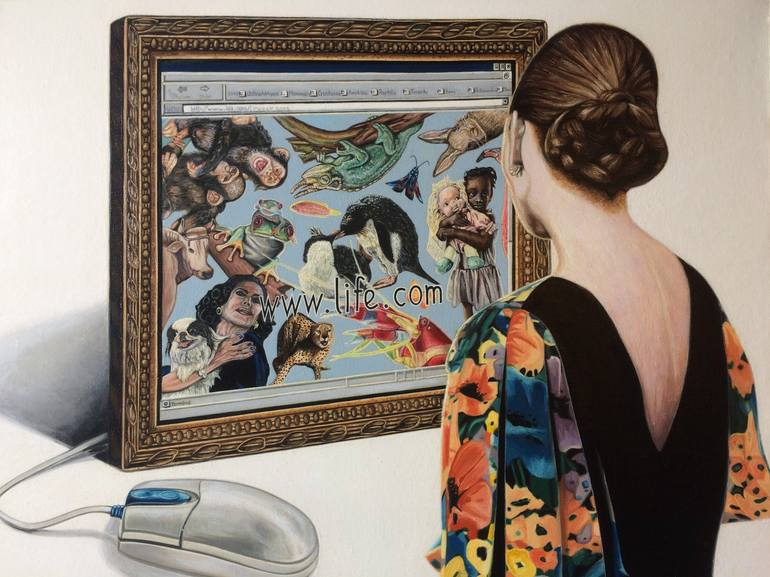





VIEW IN MY ROOM
Net Print
United States
Select a Material
Fine Art Paper
Select a Size
12 x 9 in ($40)
Add a Frame
White ($80)
About The Artwork
Oil on Belgian linen, 15.5” x 19.5” unframed (23.25” x 27.5” framed). We live in a world of our own making, obsessed with speed, and with viewing—and publishing—a multitude of images streaming over the airwaves or culled from social media portals. The difference between Western culture and that of preliterate people, therefore, is not that we are more scientific or lack symbolism but that our conceptual ideas are not unified by an all-embracing cosmology. Our experience is fragmented, fractured and saturated by the replicated image. We moderns operate in many different fields of symbolic action—informed by mass production that strips an image of its complexity, so that it resembles a sign. As Robert Hughes (28 July 1938-6 August 2012) observed, “A sign is s command—it is something you can take in at once. It means one thing and one thing only. It isn’t any better for being handmade.” (The Shock of the New, (1980)). The cultural ideas of preliterate people are unified: All their contexts of experience overlap and interpenetrate, nearly all their experience is religious. Their rituals create one single, symbolically consistent universe. The psyche is a kind of self-regulating mechanism in which the conscious and unconscious parts reciprocally influence each other. On this subject Carl Jung (26 July 1875 – 6 June 1961) wrote a massive and important study, Psychological Types, drawing on material from diverse sources, both philosophical and comparative (1921). But although Jung stresses the oppositions and compensatory mechanisms operating within the psyche, he also posits a transcendental function, the striving for integration and selfhood that he suggests is achieved in the latter part of life. In The Power if Myth, (21 June 1988), Joseph Campbell posits, “When we reach a certain age and look back over your life it seems to have had a certain order, been composed by someone, and those events that when they occurred seemed merely accidental and occasional, turn out to be the main elements in a consistent plot. Who composed this plot? And just as your dreams are composed by an aspect of your psyche by which your consciousness is unaware—so your whole life has been composed by the will within you. Just as those people whom you have met by chance have become effective agents in the structuring of your life, so you have been an agent in the structuring of other lives—and the whole thing gears together like one big symphony: Everything influencing and structuring everything else—moves out of the will into Nature.” As a ‘now’ moment is an illusion of our experience—this world is an idea. As Arthur Schopenhauer wrote in The Art of Controversy, (Die Kunst, Recht zu behalten), sec. 9, (1896), “I have an extraordinary clear consciousness of the identity of my own being with that of the external world. Nothing provides so vivid an illustration of this identity as a dream. For in a dream other people appear to be totally distinct from us, and to possess the most perfect objectivity and a nature which is quite different from ours; and which often puzzles, surprises, astonishes or terrifies us—and yet it is all our own self—it is even so with the will (wille zum leben), which sustains the whole of the external world and gives it life. It is the same will that is in ourselves, and it is there alone that we are immediately conscious of it. But it is the intellect, in ourselves and in others, which makes all of these miracles possible. For it is the intellect which everywhere divides actual being into subject and object. It is a hall of phantasmagorical mystery, inexpressibly marvelous, incomparably magical.” Our lives are akin to a web, or net of gems: every intersectional gem reflected in and by the others. Net is best understood as a totemic illustration of a certain mode of thought. Its imagery denotes different aspects of the totemic principle. Behind these figures [totems] there is a concrete and living reality: a whole complex of beliefs and rituals that involved a ritual attitude toward nature, and a cosmology that expressed the idea that humans and nature form a part of a spiritual totality. It suggests that religious symbols formulate a basic congruence between a particular style of life and a specific metaphysic and so function to synthesize a people’s ethos—the aesthetic style, tone, and quality of their life—and their world view, their most comprehensive ideas of order. Such symbolic structures have an intrinsically double aspect, being a model of “reality” and a model for “reality.” They both express the world’s climate and shape it.
Details & Dimensions
Print:Giclee on Fine Art Paper
Size:12 W x 9 H x 0.1 D in
Size with Frame:17.25 W x 14.25 H x 1.2 D in
Frame:White
Ready to Hang:Yes
Packaging:Ships in a Box
Shipping & Returns
Delivery Time:Typically 5-7 business days for domestic shipments, 10-14 business days for international shipments.
Handling:Ships in a box. Art prints are packaged and shipped by our printing partner.
Ships From:Printing facility in California.
Have additional questions?
Please visit our help section or contact us.
United States
Thousands Of Five-Star Reviews
We deliver world-class customer service to all of our art buyers.
Global Selection
Explore an unparalleled artwork selection by artists from around the world.
Satisfaction Guaranteed
Our 14-day satisfaction guarantee allows you to buy with confidence.
Support An Artist With Every Purchase
We pay our artists more on every sale than other galleries.
Need More Help?